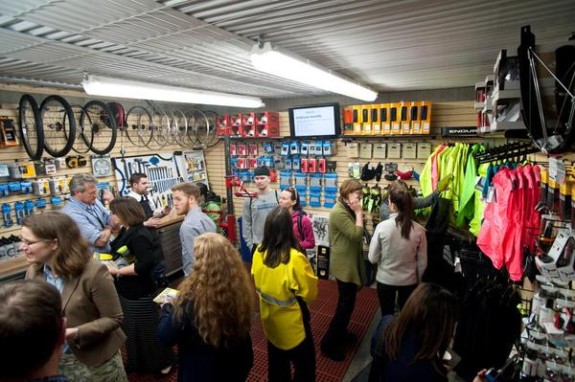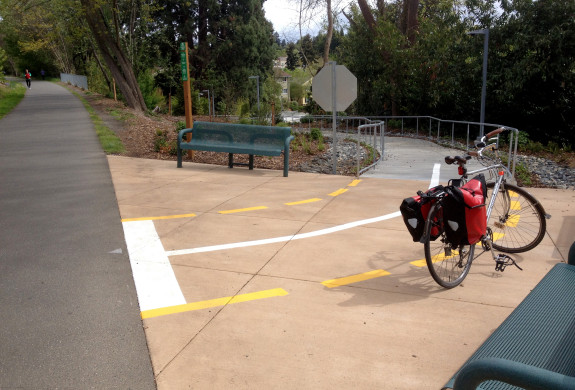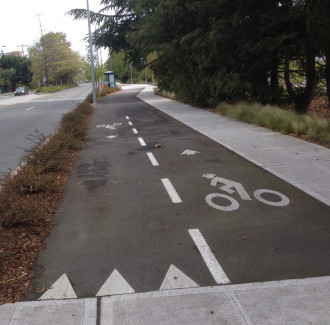
You’re on your way to work when your bike starts go get harder and harder to pedal. You try to ignore it, as though that might make the problem go away. But of course it doesn’t. You pull over and confirm: You have a flat.
Now image this: Instead of fixing the flat right there on the spot, you can just put your bike on a bus and take it to your workplace’s on-site bike shop. By the time your shift is over, your bike has two fully-inflated tires. They even gave it a tune-up while they had it. The cost to you: Free.
No, this isn’t dream world I’m talking about. It’s Seattle Children’s.
Seattle Children’s is the Seattle area’s major institution leader in encouraging employees to bike to work. Not only do they try ambitious ideas and back them up with funding, but they also get results.
More than 8 percent of Seattle Children’s employees bike to work, a feat that is extra impressive since their location in the Laurelhurst neighborhood is not in a centrally-located, dense neighborhood. But they do have one big asset: the Burke-Gilman Trail goes nearby. And they take full advantage of it.


As part of a recent campus expansion, Seattle Children’s constructed a brand new trail connection, a section of protected bike lane and a neighborhood greenway. By creating safer, easier and more direct bike connections, they figured more people would see biking as a viable option to get to work.
Oh, and they were one of the first organizations to step up and sponsor Pronto Cycle Share, earning them a station near their campus.
And it all seems to be working. Their commute plan originally called for ten percent of employees to bike to work by 2030. They’re already getting pretty close 15 years early.
Now they are going yet another step further. Seattle Children’s just opened a full service bike shop for employees. Workers can buy parts and get work done for free or at significant discount, and the repairs can happen during their shifts.
While having a safe route to bike to work is one common barrier, keeping a bike in working order is another. Seattle Children’s has invested in both issues. Of course they are ahead on their bike commute goals.
More details on the Bicycle Service Center from Seattle Children’s:
Seattle Children’s is one of only a handful of companies in the nation that offer such a service for employees.
“Seattle Children’s is committed to making bike commuting easy for faculty and staff,” said Lisa Brandenburg, hospital president, who is a bike commuter. “Seattle Children’s Staff Bicycle Service Center is an example of the type of creative project that has made us a leader in reducing drive-alone commute trips, not just in our city but in the country.”
Though Seattle Children’s has offered on-site bike maintenance from mobile bike mechanics for years, the Bicycle Service Center expands this offering by bringing a comprehensive bike shop to campus, all under one roof. The full-service repair shop will offer the following:
- Free services
- Two tune-ups per year
- Safety checks
- Air and bike chain lubrication
- Free flat repairs
- Discounts
- 10 to 30% off all gear and parts
- 50% of all additional labor costs
…
As part of its expansion plan, Seattle Children’s made a commitment to its neighbors and the City of Seattle to reduce the percentage of staff driving alone to work to just 30% by 2030. The plan calls for 10% of the hospital-based workforce to commute by bike.
“Growing the number of employees commuting by bike not only reduces our environmental footprint and contributes to the health and wellness of our staff, but it also allows Seattle Children’s to increase our capacity and ability to provide world-class healthcare to every child in the region who needs us,” said Brandenburg.
Currently, more than 8% of Seattle Children’s main campus workforce commutes by bicycle. With the addition of the Bicycle Service Center, Seattle Children’s aims to support its current bike commuters and recruit those who may still be on the fence in order to reach the 10% goal outlined in the expansion plan.
Councilmembers Jean Godden and Sally Bagshaw have praised the effort. And Bagshaw asked the big question: “Who’s next, Seattle?”
Anyone else know of another workplace in the area with anything like this? Let us know in the comments below.








Comments
16 responses to “Seattle Children’s one of few workplaces in nation with on-site bike shop”
I’m always impressed with people in healthcare walk the talk or in this case bike. That is so awesome that there are bike mechanics on call. Do you know what they get paid. Please don’t say minimum wage.
“Anyone else know of another workplace in the area with anything like this?” Microsoft at their “Microsoft- The Commons” facility has had a bike shop for at least 5 years.
Microsoft also has Pedal Dynamics at Overlake Transit Center, with discounted rates for employees (and some free tune-ups, etc. if you decline the all-you-can-eat-ORCA card benefit).
It is Eastside Ski and Sport in the commons, they are great they helped me with a build last year. FTE Microsoft employees get free and discounted tune ups (2 or 4 a year I don’t remember) and some discounts on gear.
Also FTE’s get 800 $/yr as a StayFit credit; you can spend it on stuff to stay fit like a gym membership or a bike(or parts/service)!!
Almost every building has a bike cage; complete with repair stand and secured parking. Locker rooms with showers and towel service are also in almost every building.
Don’t forget about the bike shuttle; travels between Montlake and the commons during the morning and evening commutes. Minibus that has a trailer with 12 slots for bikes one every half hour. This is open to FTE and contractors.
UW has a bike shop in the Hub: http://bike.asuw.org/.
And the U-PASS gives bike commuters discounts on some bike gear at hall health: http://www.washington.edu/facilities/transportation/node/1498, as well as discounts at Recycled Cycles and Bikesport.
This is pretty awesome. The next step would be for them to adopt the closest 2_miles of the Burke and repave it. It would have been a far better investment than the redundant low-use sidewalk with sharp rocks and handlebar level railings they installed as a connector.
This sounds like one of those snarky comments a car driver would make about money needlessly spent on dedicated cycling facilities because it doesn’t benefit motorists directly and that is baseless and sucks.
The connector provides access to and from their facilities that meets ADA requirements and city code, unlike the existing connections.
To make the connector work they needed to to make the grade pretty steep. The connector being a multi-use path like the BGT, it has to meet accessibility requirements and for a path steeper than 5% this includes handrails.
While this may net seem like a worthwhile investment of their money to some people, I am sure there are plenty of other people and in particular those with accessibility issues that appreciate where they did put their money.
Maybe.
Or maybe if it was designed thoughtfully, in addition to just “to code”, more people would use it.
Or maybe I am a believer in maintaining what we have that is already heavily used before building shiny new things.
Or maybe I’m just a snarky prick.
Code and accessibility are minimum requirements as you imply. If the designers take pride in their work, then it was done thoughtfully.
The City should take better care of the BGT. They had a contractor out on that crappy stretch of the BGT cutting roots and patching asphalt. It’s better than it has been in a long time.
Nobody’s perfect.
This IS awesome.. and pretty much the opposite of how it is at my work. Here there are free parking spaces provided (downtown no less) for people who drive to work, contribute to traffic, pollution etc., but I get passive aggressive snark for parking in my office. Hm.
Where I work we have showers some indoor bike hooks for “normal” bikes. Nobody seem to mind that I park my enormous cargo bike in my “office” (which is more a machine shop /parts warehouse), though the cubical dwellers probably couldn’t do that. (but one has parked his cargo bike in our shop a couple of times and we don’t mind). There are floor pumps available, and while there aren’t spare parts on hand, there are enough engineers around (albeit mostly E.E.) that one could find someone to do minor adjustments if needed to get home.
Now image this: Instead of fixing the flat right there on the spot, you can just put the bike in the nearest rack (which, however, may not be any too near) and take another one. When your shift is over, just take another tolerably well maintained bike. The cost to you: if you the service regularly, much less than bus fare.
Speaking of “not any too near”, I saw 3 people on Pronto bikes last Sunday (which wasn’t all that sunny), considering the limited coverage area that is pretty good, it almost ties the highest number I’ve ever seen in one day, the interesting thing about last Sunday is that none of the three were wearing the helmets Children’s paid for (or any helmet at all).
BTW, what is that grey octagon in the second picture? While I don’t have a copy of the AASHTO bike facilities guide to quote (nor I’m I likely to ever have one at $187!!), but paraphrasing from things I found on the web: “installing signs that will be ignored teaches users to ignore signs”. A caution or even yield would be fine, but an octagon?
While the above picture is path on path, the teaching people the wrong thing also applies elsewhere, if you try to make people riding bicycles wait for cars at cross walks, you just confuse the drivers who think they should be yielding at cross walks (such drivers are a minority of course, but that is no reason to be confusing them)
An interesting, but bewildering, contrast is the sign where N Northlake Pl. crosses the B.G. and meets N Northlake Way, in that case a stop sign on N Northlake Pl. makes perfect sense, N Northlake Pl. is a road, not a path or sidewalk and bicycles on the roadway have the duties of “vehicles” and do have to yield other traffic (unlike people on bicycles and on foot in crosswalks who have the right of way over vehicles) , so why the exemption?. ( if you don’t want to ride out there and see what I’m talking about, it’s on Google street view. If one does want to go for a ride, if one hustles one might make the round trip from a SLU Pronto station in half an hour, one of the University stations could be an easy ride, wearing your Children’s helmet of course)
[…] – Oh man, how come my place of work doesn’t have a bike shop? […]
So Children’s joins Microsoft and some Silicon Valley tech companies in having on-site bike repair for employees. Some employers that do this are forced into it by their locations — particularly in the Bay Area major employers are forced into isolated office parks by its particular brand of civic dysfunction preventing growth in places where infrastructure and longstanding land-use patterns naturally support non-SOV transportation. But when they do it they reinforce their isolation — who would start a business near the campus of a big company that provides the service free?
Children’s is not in that position. It’s a block away from a bike shop! It’s a quick walk from a little commercial strip and a quick roll to major grocery stores and retail, plus a variety of housing! The area around there has some major connectivity and accessibility gaps; recently Children’s has worked to close some of them, which is great! But I’m not so excited to see big employers bring services in-house when it could weaken the local options available to the general public. Children’s isn’t that isolated but it’s not perfectly connected either. Little things like this could have some impact on the future course of a neighborhood that could go either way.
[…] she went beyond just bragging about their awesome bike center. She also connected the value of biking to work to issues their patients face every day. The number […]
[…] Seattle Children’s is one of a few workplaces in the nation with an on-site, full service bike shop for employees […]